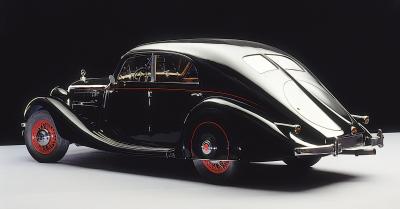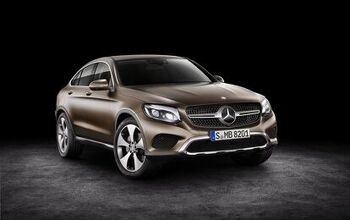Pictorial History Of The Mercedes-Benz 320

Mercedes-Benz 320 (W 142 series, 1937 to 1942) in the Streamline Saloon version, also known as “Autobahn Kurier”, 1938.
In 1937, Mercedes-Benz had a familiar problem: It lacked a car in what we would today call the “obere Mittelklasse,” or the upper middle class, that sweet spot between medium-sized vehicles and top-of-the line. Apparently, auto managers already engaged in the art of positioning. At least, that’s what the “Allgemeine Automobil-Zeitung” (AAZ or “General Automotive Magazine”) wrote when Mercedes showed its 3.2 liter Mercedes-Benz Type 320 (W 142 series) at the International Automobile and Motorcycle Exhibition (IAMA) in Berlin in February 1937.
There was ample competition. Opel showed the new Admiral, Ford fielded a 3.6-liter V8. Audi-predecessor Horch had its 930 V and 830 BL models.
Initially, the 320 was available with two wheelbases. Short (2,880 millimeters) and regular (3,300 millimeters).
The short version was offered as a bare chassis, a Cabriolet, and a Combination coupé with removable roof that did cost 12,300 Reichsmark.
The regular version was by far the most popular. Here is the on-line version of the pre-war catalog:
Mercedes-Benz 320 in its saloon version.
Saloon with 4 doors & 4 windows 8,950.00 RM
Mercedes-Benz 320 in its Cabriolet D version.
Cabriolet D with 4 doors & 4 windows 10,400.00 RM
Mercedes-Benz 320 in the Pullman-Saloon version, 1938.
Pullman saloon with 4 doors & 6 windows 9,800.00 RM
Mercedes-Benz 320 in the Pullman-Cabriolet F version.
Cabriolet F with 4 doors & 6 windows 12,500.00 RM
The Mercedes-Benz 320 was developed out of the 290 model (W 18). Its anemic 68 bhp engine was re-worked using methods familiar to any greying hot-rodder. The engine received a bigger bore (78 to 82.5 millimeters,) which lifted displacement from 2.9 to 3.2 liters. The simple updraught carburetor of the W18 was replaced by a dual downdraught carburetor. All of this yielded a whopping 10 horses more.
Completely reworking the suspension of the W18 bore fruits: Testers were delighted by the driving comfort and handling,
Mercedes-Benz 320 N (W 142 series) in the combination coupé version
Among the many body styles, the short wheelbase came as a so-called “combination coupé.” It was a convertible which also had a removable hardtop. Before leaving the garage, one had to decide which roof to leave at home.
The long-wheelbase had several cabriolets (A through F.) The Pullman saloon, the Cabriolet F and the open touring car had no trunkspace. Luggage was carried on a folding luggage rack. Special containers for luggage were sold as optional extras.
At the IAMA in February 1939, Mercedes-Benz presented a revised version of the 320 model. It’s 3.4 liter engine was adapted to the increasingly inferior fuel quality with lower octane numbers – Germany switched to liquefaction of coal.
The 320 gets drafted and goes to war
In 1939, the 320 went to war as a “Wehrmachtskübelwagen.” The last Mercedes-Benz Type 320 was built in 1942. Between 1937 and 1942, a total of 6861 vehicles were made, 1764 of which were bucket seat vehicles for the German Army.
Mercedes-Benz 320 (W 142 series, 1937 to 1942) in the Streamline Saloon version, also known as “Autobahn Kurier”, 1938.
Mercedes-Benz 320 in its Cabriolet D version.
Mercedes-Benz 320 in its Cabriolet D version.
Mercedes-Benz 320 in its Cabriolet D version.
Mercedes-Benz 320 in its Cabriolet D version.
Mercedes-Benz 320 in its Cabriolet D version.
Mercedes-Benz 320 N (W 142 series) in the combination coupé version
Mercedes-Benz 320 in the Pullman-Cabriolet F version.
Mercedes-Benz 320 in the Pullman-Saloon version, 1938.
Mercedes-Benz 320 in its saloon version.
Mercedes-Benz 320 in the Pullman saloon version without outside trunks, 1937.
Daimler-Benz AG advertisement: “Top of its class! Mercedes-Benz 320”, published in “AAZ”
The 320 gets drafted and goes to war

Bertel Schmitt comes back to journalism after taking a 35 year break in advertising and marketing. He ran and owned advertising agencies in Duesseldorf, Germany, and New York City. Volkswagen A.G. was Bertel's most important corporate account. Schmitt's advertising and marketing career touched many corners of the industry with a special focus on automotive products and services. Since 2004, he lives in Japan and China with his wife <a href="http://www.tomokoandbertel.com"> Tomoko </a>. Bertel Schmitt is a founding board member of the <a href="http://www.offshoresuperseries.com"> Offshore Super Series </a>, an American offshore powerboat racing organization. He is co-owner of the racing team Typhoon.
More by Bertel Schmitt
Latest Car Reviews
Read moreLatest Product Reviews
Read moreRecent Comments
- Varezhka Maybe the volume was not big enough to really matter anyways, but losing a “passenger car” for a mostly “light truck” line-up should help Subaru with their CAFE numbers too.
- Varezhka For this category my car of choice would be the CX-50. But between the two cars listed I’d select the RAV4 over CR-V. I’ve always preferred NA over small turbos and for hybrids THS’ longer history shows in its refinement.
- AZFelix I would suggest a variation on the 'fcuk, marry, kill' game using 'track, buy, lease' with three similar automotive selections.
- Formula m For the gas versions I like the Honda CRV. Haven’t driven the hybrids yet.
- SCE to AUX All that lift makes for an easy rollover of your $70k truck.















































Comments
Join the conversation
That Streamlined saloon version must be the inspiration of today's CLS, a lower, swoopier version of the company,s midzise sedan.
That is a car driven people who say "Farewell, Dr. Jones".